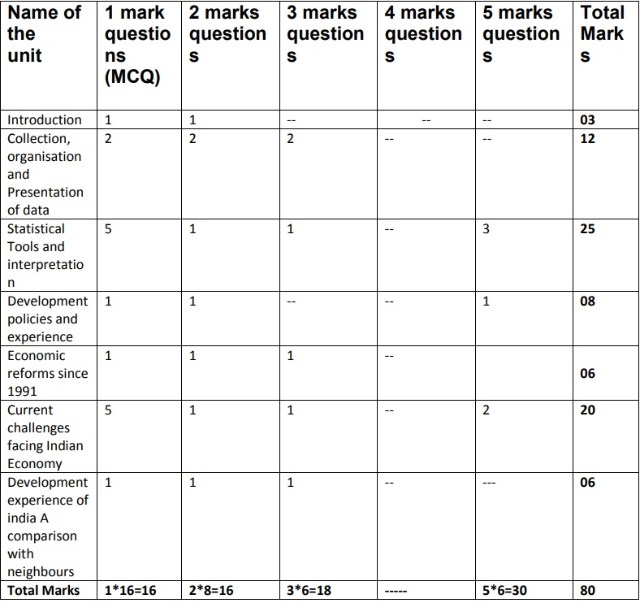HPBOSE Class 11 Economics Syllabus 2023-24: Download the latest HP Board Class 11 Economics Syllabus for the current academic session, 2023-24. Knowing the latest syllabus is essential for the class 11 students as it will help them understand the amount of stuff they have to prepare for their monthly tests and the annual exam. The syllabus includes all crucial exam-related details including topics to prepare, unit-wise marks distribution and question paper design. This information is enough for students to plan their studies and prepare well for the HP Board Class 11 Economics Exam 2023-24.
HP Board Class 11 Economics Syllabus 2023-24
COURSE STRUCTURE
|
Economics (Theory) |
80 Marks |
|
Internal Assessment |
20 Marks |
|
Total |
100 Marks |
Course Content
PART A STATISTICS FOR ECONOMICS
1. Introduction
2. Collection and Organization and Presentation of Data
3. Statistical Tools and Interpretation
PART B INDIAN ECONOMIC DEVELOPMENT
4. Development Policies and Experience (1947-90)
5. Economic Reforms since 1991
6. Current Challenges facing Indian Economy
7. Development experience of India-A 7 comparison with neighbors
PART A : STATISTICS FOR ECONOMICS
In this course, the learners are expected to acquire skills in collection organization and presentation of quantitative and qualitative information pertaining to various simple economic aspects systematically It also intends to provide some basic statistical tools to analyze, interpret any economic information and draw appropriate inferences. In this process, the learners are also expected to understand the behavior of various economic data. (Periods 8)
Unit 1: Introduction
What is Economics? Meaning, scope and importance of statistics in Economics
Unit 2: Collection, Organization and Presentation of data
Collection of data-sources of data-primary and secondary, how basic data is collected; methods of collecting data; Some important sources of secondary data Census of India and National Sample Survey Organization.
Organization of Data : Meaning and types of variables Frequency Distribution.
Presentation of Data : Tabular Presentation and Diagrammatic Presentation of Data, Geometric forms (bar diagrams and pie diagrams), (i) Frequency diagram (histogram, polygon and ogive) and (iii) Arithmetic line graphs (time series graph)
Unit 3: Statistical Tools and Interpretation
(For all the numerical problems and solutions, the appropriate economic interpretation may be attempted. This means, the students need to solve the problems and provide interpretation for the results derived)
Measures of Central Tendency-mean (simple and weighted, median and mode.
Measures of Dispersion-absolute dispersion (range, quartile deviation, mean deviation and standard deviation), relative dispersion (co-efficient of quartile deviation, co-effecient of mean deviation, co-efficient of variation); Lorenz Curve : Meaning and its application
Correlation-meaning, scatter diagram; Measures of correlation-Karl Pearson’s method (two variables ungrouped data) Spearman’s rank correlation
Introduction to Index Numbers -meaning, types-wholesale price index consumer price index and index to industrial production, uses of index numbers; Inflation and index numbers
PART-B: INDIAN ECONOMIC DEVELOPMENT
Unit 4: Development Policies and Experience (1947-90)
A brief introduction of the state of Indian economy on the eve of independence
Common goals of Five Year Plans.
Main features, problems and policies of agriculture (institutional aspects and new agricultural strategy, etc.) industry (industrial licensing, etc.) and foreign trade
Unit 5: Economic Reforms since 1991
Need & main features-liberalization, globalization and privatization An appraisal of LPG policies.
Unit 6: Current challenges facing Indian Economy
Poverty -absolute and relative Main programmes for poverty alleviation : A critical assessment;
Rural development : Key issues-credit and marketing-role of cooperatives; agricultural diversification; alternative farming-organic farming.
Human Capital Formation: How people become resource Role or human capital In economic development, Growth of Education Sector in India
Employment : Growth, informalisation and other issues : Problems and policies
Infrastructure: Meaning-and Types Case Studies Energy and Health problems and Policies -a critical assessment;
Sustainable Economic Development:
Meaning: Effects of Economic Development on Resources and Environment
Download the complete syllabus from the following link:
HP Board Class 11 Economics Exam Pattern and Marking Scheme 2024
Unit-Wise Marks Distribution
|
Unit No. |
Particulars |
Marks assigned |
|
|
Part-1 Statistics for Economics |
|
|
1 |
Introduction Chapter -1: Concept of Economics and significance of Statistics in Economics |
3 |
|
2 |
Collection, Organisation and Presentation of Data Chapter-2: Collection of Data Chapter-3: Census and Sample Methods of collection of data Chapter-4: Organisation of Data Chapter-5: Presention of Data- Textual and Tabular Presentation Chapter-6: Diagrammatic Presentation of Data : Bar Diagrams and Pie Diagrams Chapter-7: Frequency Diagrams : Histogram, Polygon and Ogive Chapter-8: Arithmetic Line-graph or Time Series Graphs |
12 |
|
3 |
Statistical Tools and interpretation Chapter-9: Measures of Central Tendency- Arithmetic Mean Chapter-10: Measures of Central Tendency- Median and Mode Chapter-11: Measures of Disperson Chapter-12: Correlation Chapter-13: Index Numbers |
25 |
|
4 |
Part-2 Indian Economic Development Development policies and experience Chapter-1:Indian Economy of the eve of independence Chapter-2: Econimic planning in india : Common goals of five year Plans and Development Strategies till 1991 Chapter-2: Features Problems and Policies of Agriculture Chapter-4: Features Problems and Policies of Industry Chapter-5: Foreign Trade – Features Problems and Policies |
08 |
|
5 |
Economic reforms since 1991 Chapter-6: Economic reforms since 1991 or New Economic Policy |
06 |
|
6 |
Current challenges facing Indian Economy Chapter-7: Poverty Chapter-8: Rural Development: Issues relating to credit marketing, agricultural diversification and organic farming. Chapter-9: Human capital formation Chapter-10: The employment problem Chapter-11: Infrastructure Chapter-12: Sustainable Economic Development |
20 |
|
7 |
Development Experience of India – A comparison with neighbours Chapter-13: Development experience of india: A comparison with Pakistan and China |
06 |
The Annual theory paper will be of eighty 80 marks.
Design of HPBOSE Class 11 Economics Question Paper 2024 (Blueprint)
Economics (Theory) paper in HP Board Class 11 will be of 80 Marks with a time duration of 3 hours.

Blueprint of MCQs
Each MCQ carries 1 mark only
No internal choice be given in the MCQ section
Prescribed Books
Statistics for Economics NCERT Publication
Indian Economic Development NCERT Publication

